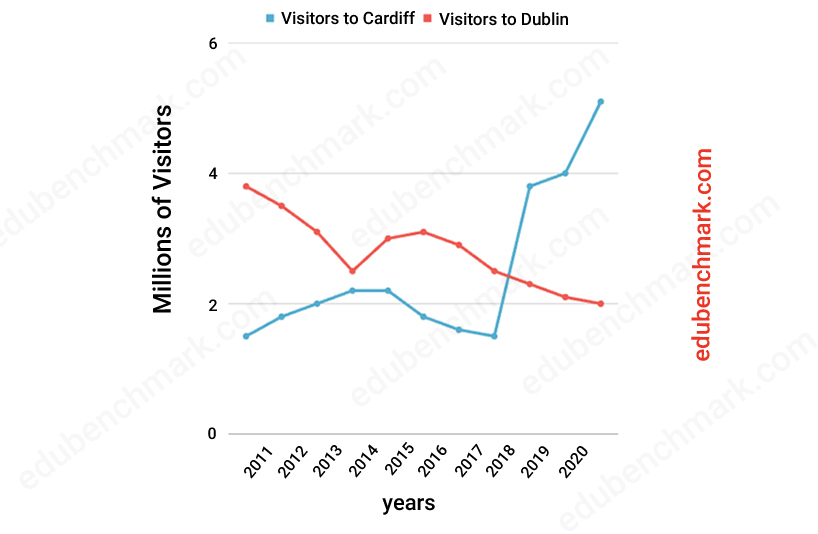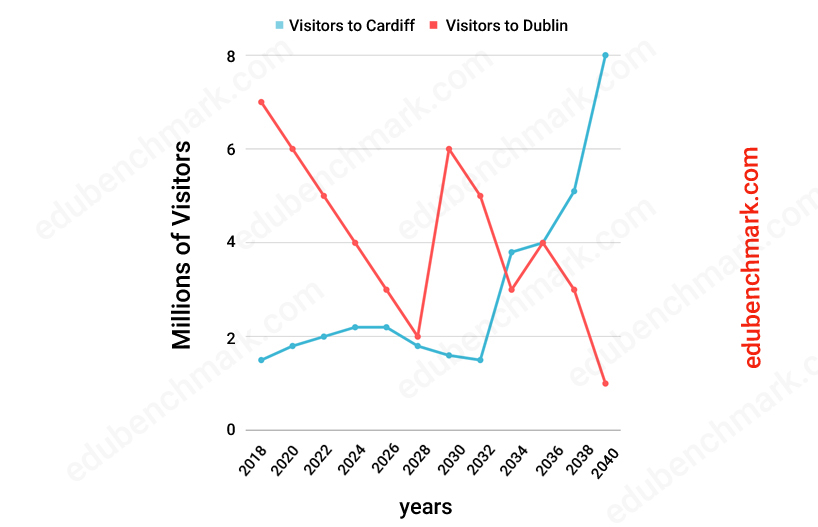

This guide covers important IELTS line graph examples including questions of IELTS Academic writing task 1. Let’s start preparation with Benchmark IELTS!
Table of Contents
1. IELTS Line Graph Overview
Line graphs are a very common IELTS writing task 1 question type. You will be given a line graph (or sometimes two) with multiple lines that illustrate a change over time.
The line graph(s) will have two axes; the X-axis (horizontal) will typically show the time period and the Y-axis (vertical) will show the measurement.
You should spend 20 minutes completing this task and write at least 150 words (aim for around 160-190) – you can read this guide on suggested Academic Writing Task 1 word length.
1.1 Objective
The main aim of this task is to produce a formal report that summarises and compares the main features of the IELTS line graph(s). Here are some examples of formal language you could use in your report:
| Informal | Formal |
|---|---|
| The graph shows very big changes … | The graph shows the major changes… |
| I can see on the graph that… | It is clear from the graph that… It can be observed from the graph that… |
1.2 Skills Used
You are being tested on your ability to select the key features from the graph and present the main trends in a summary in a formal report. You also need to compare the data when it’s appropriate.
2. IELTS Task 1 Line Graph Questions
You may be given one or two line graphs that illustrate changes in different categories over a period of time. The time period could occur in the past, or range from the past to the predicted future.
Here are some IELTS Line Graph examples:
2.1 Line Graph in the Past
The graph gives information about the visitors to Cardiff and Dublin from 2010 to 2020.
Summarise the information by selecting and reporting the main features and make comparisons where relevant.
Write a minimum of 150 words



2.2 Line Graph from the Past to Predicted Future
The graph gives information about the actual and predicted number of visitors to Cardiff and Dublin from 2018 to 2040.
Summarise the information by selecting and reporting the main features and make comparisons where relevant
Write a minimum of 150 words


3. Structure for Line Graph Task 1 Questions
When you are producing an IELTS writing task 1 report, you should always include:
- An introduction
- An overview
- Two main body paragraphs
The above IELTS report writing structure can be followed on other Academic Task 1 types including bar graph, process diagram, maps and pie chart.
Whether you are taking the paper or computer-based IELTS test, you should leave a line between each paragraph so it is clear for the examiner.
Read on for more detail on what to include in each paragraph…
3.1 Introduction
Your introduction should always paraphrase the given statement. Paraphrasing is a key skill that is useful in all parts of the IELTS academic exam, especially writing. You are showing the examiner that you have understood the statement by putting it in your own words. This might be by using synonyms or what are sometimes called parallel expressions (phrases with the same meaning). You can also change the word order in the statement or the class of a word (e.g. change a verb to a noun).
You should not try to memorise an answer, but you can learn some useful expressions to start your introduction. Here are some you can use for line graphs:
- The graph shows information about…
- The graph shows…
- The graph illustrates…
- The line graph compares…
- The line charts detail…
Look at the example paraphrased statement for a line graph:
Example of paraphrasing
Original statement:
The graph gives information about visitors to Cardiff and Dublin from 2010 to 2020.
Paraphrased statement:
The graph shows information about how many people visited Cardiff and Dublin over a ten-year period between 2010 and 2020.
Changes:
The graph gives information about…
The graph shows…
…visitors to Cardiff and Dublin…
…how many people visited Cardiff and Dublin…
from 2010 to 2020
over a ten-year period between 2010 and 2020
3.2 Overview
Your overview is probably the most important part of your IELTS writing task 1 report. In fact, without it you will struggle to score above a band score 5 in task achievement (see our section on IELTS Band Descriptors Explained for more details).
An overview should be one paragraph that summarises the key trends shown in the line graph(s). The key trends are the main increase and decreases in the graph, in other words, the most noticeable features. Do not go into too much detail by referring to specific figures, save the detail for your main body paragraphs.
The best way to start your overview paragraph is with ‘Overall…’ as this clearly shows the examiner where to find your overview. You can also use phrases such as ‘In summary…’ or ‘to summarise’.
You do not need to write a separate conclusion (you will need one for writing task 2).
3.3 Main Body Paragraphs
Your body paragraphs should go into more detail about the key information in the line graph(s). You need to make your paragraphs clear and organise them logically. Here’s a possible example:
Main Body Paragraph 1– Describe the changes in one category (e.g., travellers to Cardiff)
Main body paragraph 2– Describe the changes in another category (e.g., travellers to Dublin) and make comparisons with the first category
The content of your body paragraphs will depend on the line graph(s) but here are some general points to consider:
- Be selective when choosing what lines to describe (you are being marked on your ability to report on the key features)
- Be accurate when you are reading and writing about the data
- Refer to any units given on the graph’s axes (such as %, £, $)
- Use a range of linking words, adjectives, adverbs, nouns and verbs (see Vocabulary for IELTS Line Graph)
- Use different time expressions to describe the passage of time
- Do not make spelling mistakes
- Use a range of vocabulary and grammatical structures to describe change (see Grammar for IELTS Writing Task 1 Line Graph)
4. IELTS Writing Task 1 Band Descriptors Explained
Here’s a link to our guide to IELTS Writing Band Descriptors with all you need to know about each section.
5. Vocabulary for IELTS Line Graph
5.1 Language to Describe Trends
A line graph will illustrate different trends that you need to describe. This could be an upward trend, a downward trend or other noticeable trends. Here are some useful nouns and verbs to help you describe each type:
| Upward Trend | Downward Trend | Other |
|---|---|---|
| Go up | Decrease/a decrease | Plateau |
| Increase/ an increase | Decline/ a decline | Hit a low of |
| Grow/a growth | Drop/ a drop | Bottom out |
| rise/ a rise | Fall/ a fall | A dip |
| Fluctuation | ||
| Remain steady | ||
| Remain stable | ||
| Level off | ||
| Remain unchanged |
5.2 Verbs and Adjectives to Describe Change
You can use a combination of a verb + adverb to describe the trends more accurately and avoid repetition.
Remember, if the data in your line graph occurred in the past, you will need to use the past simple form of the verb. If the data is from the present, you should use the present form of the verb
Here are some examples of verbs + adverbs to describes changes in a line graph:
| Verb | Adverb | Example |
|---|---|---|
| Decline | Considerably | The number of visitors to Cardiff declined considerably from 2010 to 2020. |
| Fall | Sharply | The number of visitors to Cardiff fell sharply from 2015 to 2020. |
| Increase | Dramatically | The number of visitors to Cardiff increased dramatically from 2011 to 2014. |
| Decrease | Slightly | The number of visitors to Cardiff decreased slightly from 2010 to 2015. |
| Grow | Steadily | The number of visitors to Cardiff grew steadily from 2018 to 2020. |
| Shoot up | Significantly | The number of visitors to Cardiff shot up significantly from 2010 to 2012. |
| Rise | Gradually | The number of visitors to Cardiff rose gradually from 2010 to 2020. |
| Go up | Rapidly | The number of visitors to Cardiff went up rapidly from 2015 to 2020. |
These verbs do not require an adverb (their meaning already implies a big change):
- Plunge
- Plummet
- Jump
- Rocket
- Soar
- Surge
5.3 Adjectives and Nouns to Describe Change
You can also describe changes in a line graph using an adjective + noun phrase.
For example:
| Adjective | Noun | Example |
|---|---|---|
| Considerable | Decrease | There was a considerable decrease in the number of visitors from 2010 to 2020. |
| Dramatic | Decline | There was a dramatic decline in the number of visitors from 2015 to 2020. |
| Gradual | Drop | There was a gradual drop in the number of visitors from 2011 to 2014. |
| Rapid | Fall | There was a rapid fall in the number of visitors from 2010 to 2015. |
| Sharp | Improvement | There was a sharp improvement in the number of visitors from 2018 to 2020. |
| Significant | Rise | There was a significant rise in the number of visitors from 2010 to 2012. |
| Slight | Fluctuation | There was a slight fluctuation in the number of visitors from 2010 to 2020. |
| Steady | Increase | There was a steady increase in the number of visitors from 2015 to 2020. |
5.4 Linking Words
You should use linking words in Academic IELTS writing task 1 as they will help to organise your report and they will improve your score in Coherence and Cohesion. Here are some useful words to use in writing task 1:
- To begin with,…
- To start with,…
- And then,…
- At this point,…
- Subsequently,…
- After this,…
- Then,…
- Afterwards,…
- Finally,…
- …with the figure at _____
5.5 Time Expressions
Writing about a line graph will require you to describe the passing of time. Here are some expressions to help you avoid repetition when talking about time:
| Time Phrase | Example Sentences |
|---|---|
| At the beginning of the given period… | At the beginning of the given period, Dublin had far more visitors than Dublin. |
| At the end of the period… | At the end of the period, the number of visitors to Cardiff exceeded that of Dublin. |
| In the first year… | In the first year, Cardiff had about 1.8m visitors. |
| In the final year… | In the final year, Dublin had exactly 2m visitors |
| …from…to… | Dublin had an increase of 2m visitors from 2010 to 2020. |
| …between…and… | Cardiff saw 3m visitors between 2010 and 2020. |
| The next two days showed… | The next two days showed an increase in visitors from 2m to 3m. |
| …in the following three days… | The number of visitors increased in the following three days from 2m to 3m. |
| Over the next two days… | Over the next two days, the number of visitors fell to about 2m. |
6. Grammar for IELTS Writing Task 1 Line Graph
Using a range of grammatical structures will increase your score in Grammatical Range and Accuracy. Here are some example structures that you can use in your own writing:
6.1 After + -ing + adverb
Example:
After falling considerably to 2.5 million in 2015, the numbers then rose dramatically to 5 million in 2020.
6.2 Having + past participle + adverb
Example:
Having fallen considerably to 2.5 million in 2015, the numbers then rose dramatically to 5 million in 2020.
6.3 After which/at which point
You can join two changes together by adding after which or which point and an additional clause.
Examples:
The number of visitors to Cardiff dropped slightly to 1.5 million in 2015, after which point there was a sharp rise to 4 million in 2018.
The number of visitors to Dublin increased slightly to 6 million in 2015, at which point there was a considerable decrease to 4 million in 2018.
7. IELTS Writing Task 1 Line Graph Sample Answer
The graph gives information about the visitors to Cardiff and Dublin from 2010 to 2020.
Summarise the information by selecting and reporting the main features and make comparisons where relevant.
Write a minimum of 150 words



Sample
The graph shows information about how many people visited Cardiff and Dublin over a 10-year period between 2010 and 2020.
Overall, what stands out from the graph is that there was an upward trend in the number of visitors to Cardiff, but the number of visitors to Dublin saw a significant decrease over the period. A further additional point is that Dublin had more visitors in 2010, but in 2020, Cardiff was much more popular than Dublin.
In detail, the number of visitors to Cardiff started at around 1.5 million (m) in 2010 and then the figure rose steadily to about 2.3m in 2013. After that, the figure levelled off and stayed at 2.3m until 2014. Having fallen slightly to about 1.7m in 2017, the number of visitors then soared, rising sharply to just under 4m in 2018. Lastly, there was a gradual increase, with the final figure finishing at 5m in 2020.
However, if we look at the number of visitors to Dublin, the trend was very different. The number of visitors started at around 4.9 m in 2010, after which there was a considerable fall to approximately 2.3m in 2013. After a slight increase to 2.5m in 2015, the figure then declined steadily to just over 2m before finishing at 2m.
7.1 Sample Answer Commentary
The report above would receive an estimated 9.0 overall in the IELTS writing task 1 Academic paper.
It has been organised into four logical paragraphs that are clearly divided into an introduction, overview, and two separate body paragraphs. The minimum 150 word count has been exceeded. The report is written in a formal style (the writer has not included their opinion and has not used informal language).
The overview paragraph has been clearly signposted using ‘overall’ and the introductory phrase ‘what stands out from the graph is that…’ The overview describes the main trends of the line graph and does not include any specific figures.
The dates of the graph have been referred to accurately and the past tense has been used throughout the report.
A range of past simple verb + adverb constructions have been used to describe changes in the data e.g., ‘rose steadily’. Other language to describe change has been used, such as ‘levelled off’, ‘rising sharply’, ‘gradual increase’, ‘considerable fall’ and ‘declined steadily ‘.
A range of grammatical constructions have been used, for example, ‘having fallen slightly’ (having + past participle) ‘…after which there was a considerable fall’ (after which/at which point).
8. Common Errors and How to Avoid Them
Problem 1
Trying to describe every detail of the line graph.
Solution 1
You need to demonstrate your ability to select the key features from the graph. You will not lose marks for leaving out any data points. You do not have the time to write about every feature in 20 minutes. Instead, focus your time and energy on the figures in the graph that are the highest, the lowest, and the most interesting figures.
Problem 2
Not referring to the figures when describing the data.
Solution 2
You should always refer to the figures (e.g., number of visitors) in your main body paragraphs. By doing this, you are fulfilling the Task Achievement criteria and demonstrating to the examiner that you have understood the graph. See the examples below:
Incorrect
The number of visitors to Cardiff dropped slightly in 2015, after which point there was a sharp rise in 2018.
Correct
The number of visitors to Cardiff dropped slightly to 1.5 million in 2015, after which point there was a sharp rise to 4 million in 2018.
9. Quiz- Check Your Understanding
Take this short quiz to test your understanding of writing task 1 and line graphs:








